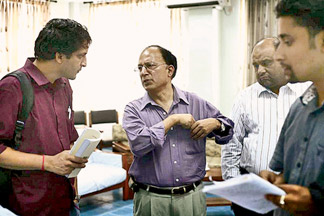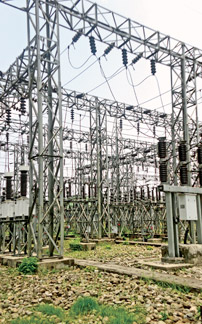|
Only Sri Lanka and Maldives balance demand and supply
rates:
Call to alleviate power shortages among SAARC nations
By Indunil THENUWARA after a tour of Nepal
|

Director of Nepal Electricity Authority’s Department of Power
Trade, Sher Singh Bhat speaks to regional journalists
|
South Asia is home to over 1.6 billion people, about 22 percent of
the total global population. It consists of a land mass of 5,130,746km2.
However, it is the least integrated region in the world and the South
Asian Association for Regional Cooperation (SAARC) is the only regional
bloc which has no energy sharing agreements despite having huge
potential for such arrangements.
The region remains energy-starved with Sri Lanka and Maldives being
the only countries which are currently balanced in their energy demand
and supply rates. All other countries including regional power India
suffer from a huge power deficit, Director of Nepal Electricity
Authority's Department of Power Trade, Sher Singh Bhat told a group of
SAARC media personnel who visited the Kathmandu electricity transmission
substation as part of a recent media program in Nepal.
He cited increasing deficits in the power sector, dominance of a
single fuel, limited use of renewable energy sources and high dependence
on traditional sources and the lack of energy improvement methods,
funds, proper policies and framework as some of the reasons which have
led to the energy crisis.
"It might deepen further, resulting in huge impacts on economic
growth and poverty levels of the region if proper measures are not
introduced to solve the issue," he said. The energy crisis can affect
gender issues too, as it is mostly women who have to work in the dark in
their kitchens late at night, Bhat said.
|

Kathmandu electricity transmission substation |
He described the India/Bhutan interconnection as the only
synchronised exchange in the region which can transmit power. Though the
India/Nepal transmission line will also exchange power, it won't be a
synchronised system. India and Bangladesh also signed an agreement in
2010 for the cross-border transmission of power. Together with the
existing and planned connectivity between India and Bhutan and the
planned transmission project between India and Sri Lanka, these will
create the infrastructure for sub-regional power trade, he said.
Bhat said that since all regional power sharing interconnections will
run through India, the regional power needs to be open for such plans to
succeed. Initiatives also have to be made on the improvement of software
and infrastructure related to energy for these measures to bear fruit,
he said.
The World Bank is concentrating on improving the energy resources in
the region alongside various energy centres, taskforces and expert
groups from the region.
Addressing the journalism workshop, World Bank Country Manager for
Nepal Tahseen Sayed said: "The Bank has, as its priority, electricity
and energy; trade, trade facilitation and transport; and water and
natural resources management. An example is its approving financing for
the first high voltage electricity transmission line between India and
Nepal, which is capable of trading 1,000MW of power, potentially
relieving Nepal's crippling energy shortages in the short term and help
develop the country's vast hydro power resources for export to the
region in the long run."
Feasibility studies have also confirmed the technical and economic
viability of exporting electricity surpluses during the summer from
existing hydro power plants in Tajikistan and the Kyrgyz Republic as a
solution to the power shortages in Pakistan and Afghanistan. Meanwhile,
India and Bangladesh are exploring transit and trade opportunities
around hydro power and gas resources in India's north east.
She said that trade in energy within the South Asian region is almost
non-existent. However, Afghanistan and Nepal could together produce
100,000MW of hydro power, alleviate the crippling power shortages which
have led to the loss of many jobs in the region, reduce the growing
dependence in the region on fossil fuels and lower carbon emissions.
World Bank Chief Economist for South Asia Kalpana Kochhar, who joined
the workshop via video-conference from Washington DC, said the massive
energy shortages experienced by all SAARC countries except Sri Lanka
hamper the achievement of their economic development goals. One third of
the global population without access to the electricity supply are from
South Asia which is the poorest region in the world, she said.
"SAARC countries suffer from a massive demand and supply gap in the
energy sector and experience daily power cuts in varying degrees. Only
Sri Lanka where 80 percent of the population has access to the national
grid doesn't currently suffer from energy shortages." she said.
The population that remains without electricity in the SAARC region,
where the rate of electrification is only 68.5 percent, is 493 million
(according to 2009 figures). The global electrification rate is 80.5
percent while the rate in developing countries is 74.7 percent.
However, a renewed interest is being shown in the region with regard
to hydro power generation with new projects being earmarked in Nepal and
Bhutan.
The World Bank is also working on boosting the power generation in
the region, Kochhar said. Optimising the region's power supply through
more regional investments is the key to solving the energy crisis, she
said.
The journalism workshop on 'Regional Cooperation in South Asia' was
organised by the World Bank and the Thomson Reuters Foundation and was
held over three days. Journalists representing media organisations from
Sri Lanka, Pakistan, Nepal, Bangladesh, Maldives, Bhutan and Afghanistan
participated in the program.
|

